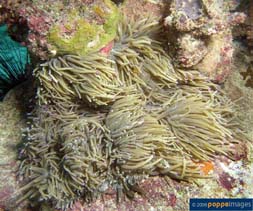Macrodactyla doreensis (Quoy & Gaimard, 1833)
Corkscrew tentacle sea anemone
Classification / Names Common names | Synonyms | CoL | ITIS | WoRMS
| Actiniaria | Actiniidae
Environment: milieu / climate zone / depth range / distribution range Ecologia
; distribuzione batimetrica ? - 15 m (Ref. 125532). Tropical
Distribuzione Stati | Aree FAO | Ecosystems | Presenze | Introduzioni
Northwest Pacific, Western Central Pacific.
Length at first maturity / Size / Peso / Age
Maturity: Lm ? range ? - ? cm
Short description Morfologia
Oral disc is usually around 20 to 30 cm in diameter and can grow up to 50 cm in larger individuals. Tentacles are slender, and may appear tightly coiled or curled near the tips. These tentacles are closely arranged at the circumference of the oral disc, gradually becoming sparse or absent towards the mouth. Oral disc and tentacles vary in color from brown, green, to purplish-gray. The striated pattern is due to white stripes radiating from the mouth, which may extend onto the tentacles. Distinctive white spots are present on the body column.
In shallow waters, to depths of around 15 meters. Has a symbiotic zooxanthellae, which produces food through photosynthesis. Serves a shelter for several anemone shrimps and fishes (Ref. 125532).
Life cycle and mating behavior Maturità | Riproduzione | Deposizione | Uova | Fecundity | Larve
Members of the class Anthozoa are either gonochoric or hermaphroditic. Mature gametes are shed into the coelenteron and spawned through the mouth. Life cycle: The zygote develops into a planktonic planula larva. Metamorphosis begins with early morphogenesis of tentacles, septa and pharynx before larval settlement on the aboral end.
Main reference
Bibliografia | Coordinatore | Collaboratori
Bisby, F.A., M.A. Ruggiero, K.L. Wilson, M. Cachuela-Palacio, S.W. Kimani, Y.R. Roskov, A. Soulier-Perkins and J. van Hertum. 2005. (Ref. 19)
IUCN Red List Status (Ref. 130435)
CITES status (Ref. 108899)
Not Evaluated
CMS (Ref. 116361)
Not Evaluated
Threat to humans
Human uses
| FishSource |
Strumenti
Informazioni ulteriori
Fonti Internet
BHL | BOLD Systems | CISTI | DiscoverLife | FAO(Publication : search) | Fishipedia | GenBank (genome, nucleotide) | GloBI | Gomexsi | Google Books | Google Scholar | Google | PubMed | Hexacorallians of the World | Tree of Life | Wikipedia (Go, ricerca) | Zoological Record
Estimates based on models
Price category
(Ref. 80766):
Unknown.



